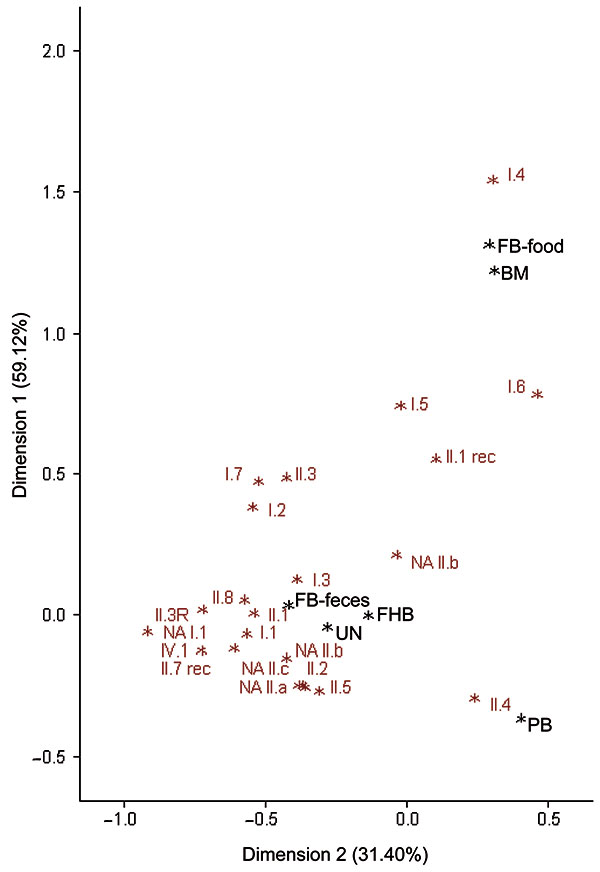Volume 16, Number 4—April 2010
Research
Use of Norovirus Genotype Profiles to Differentiate Origins of Foodborne Outbreaks
Figure

Figure. Two-dimensional display of the correspondence analysis of 6 norovirus genotype profiles based on nucleotide sequences in which points close to each other are similar with regard to the pattern of relative frequencies across genotypes. Dimension 1 explains 59.12% and dimension 2 an additional 31.40%. In dimension 1, foodborne-feces (FB-feces; i.e., outbreak reported to be caused by food with the outbreak strain detected in human feces only) and bivalve mollusk (BM) genotype profiles are mutually similar and differ from other profiles; the most distinct profile is person-borne (PB; i.e., an outbreak reported to be caused by person-to-person transmission with the outbreak strain detected in human feces). In dimension 2, food handler–borne (FHB; i.e., outbreak reported to be caused by an infected food handler contaminating the food with the outbreak strain detected in human feces), FB-feces, and unknown (UN; i.e., mode of transmission was not reported or was reported to be unknown with the outbreak strain detected in human feces) mutually correspond and differ from the mutually corresponding foodborne-food (FB-food; i.e., outbreak reported to be caused by food with the outbreak strain detected in food), BM, and PB.
1Members of the Food-Borne Viruses in Europe Network: B. Böttiger, K. Mølbak, C. Johnsen (Denmark); K.-H. von Bonsdorff, L. Maunula, M. Kuusi (Finland); P. Pothier, K. Balay, J. Kaplon, G. Belliot, S. Le Guyader (France); E. Schreier, K. Stark, J. Koch, M. Höhne (Germany); G. Szücs, G. Reuter, K. Krisztalovics (Hungary); Ireland: M. Lynch, B. Foley, P. McKeown, S. Coughlan (Ireland); E. Duizer, A. Kroneman, Y. van Duynhoven (the Netherlands); K. Vainio, K. Nygard, G. Kapperud (Norway); M. Poljsak-Prijatelj, D. Barlic-Maganja, A. Hocevar Grom (Slovenia); F. Ruggeri, I. Di Bartolo (Italy); A Bosch, A. Dominguez, J. Buesa, A. Sanchez Fauquier, G. Hernández-Pezzi (Spain); K.-O. Hedlund, Y. Andersson, M. Thorhagen, M. Lysén, M. Hjertqvist (Sweden); D. Brown, B. Adak, J. Gray, J. Harris, M. Iturriza (United Kingdom).